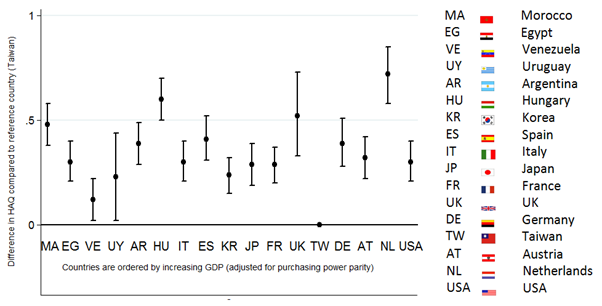Session Information
Title: Rheumatoid Arthritis - Clinical Aspects (ACR): Comorbidities, Treatment Outcomes and Mortality
Session Type: Abstract Submissions (ACR)
Background/Purpose
Physical function is an important outcome in RA and is essential for patients’ quality of life. Is has not yet been sufficiently explored whether country level differences in reported function exist, and whether they interact with individual level factors. The objective of this study was to understand which individual or country level socio-economic factors contribute to functional status of RA patients.
Methods
Data from a cross-sectional multinational (17 countries) study (COMORA) was used. Contribution of age, gender, education, employment to function (as measured by the HAQ) were explored, adjusting for potential confounders. Adjusted differences (Bonferroni correction) between countries were tested. Taiwan was chosen as the reference (country with lowest mean HAQ). Further, country was replaced by gross domestic product (GDP) (low vs high GDP), and contribution of socio-economic welfare was investigated. Improvement in R-square of the two models that included either country or GPD was compared. Interactions between (1) education (2) age and (3) gender with country and GDP were tested.
Results
A total of 3920 RA patients from 17 countries (range 30 to 411) were included in COMORA. Mean age was 56 y.o. (SD13), 82% females, 35% and 39% had primary and secondary education, respectively. Mean HAQ was 1.0 (range 0.7 (Taiwan) – 1.5 (Morocco)). Gradients in HAQ across individual socio-economic factors were seen for education and gender but not age, after adjusting for individual disease characteristics and disfavouring low educated (β=0.16 vs high educated) and females (β=0.11 vs males). Final model was adjusted for comorbidities (Wolfe-Michaud index), total joint count, swollen joint count, erythrocyte sedimentation rate, and marital status. Country differences in HAQ varied from 0.11 (Venezuela) to 0.74 (Netherlands) compared to Taiwan, after adjustment for individual factors (Figure 1). Low GDP countries had 0.11 higher score on HAQ compared to high GDP countries. Contribution of country to R-square (model fit) was 0.05 and of GDP 0.01 (negligible). Interactions were either not statistically significant or not clinically relevant after stratification.
Conclusion
Among socio-economics factors, female gender and low education were independently associated with worse physical function after adjusting for individual disease characteristics. While substantial differences in HAQ exist between countries, socio-economic welfare did not explain these differences. Other cultural factors should be examined. Awareness of existing inequalities is a first step towards clinical and policy actions to reduce them.
Figure 1. Difference in HAQ score between countries, adjusted for confounders.
Disclosure:
P. Putrik,
None;
S. Ramiro,
None;
A. Keszei,
None;
I. Hmamouchi,
None;
M. Dougados,
None;
T. Uhlig,
None;
T. K. Kvien,
None;
A. Boonen,
None.
« Back to 2014 ACR/ARHP Annual Meeting
ACR Meeting Abstracts - https://acrabstracts.org/abstract/physical-function-of-patients-with-ra-varies-importantly-across-countries-and-these-differences-are-not-attributed-to-gdp-results-from-multi-national-study-with-17-countries/

